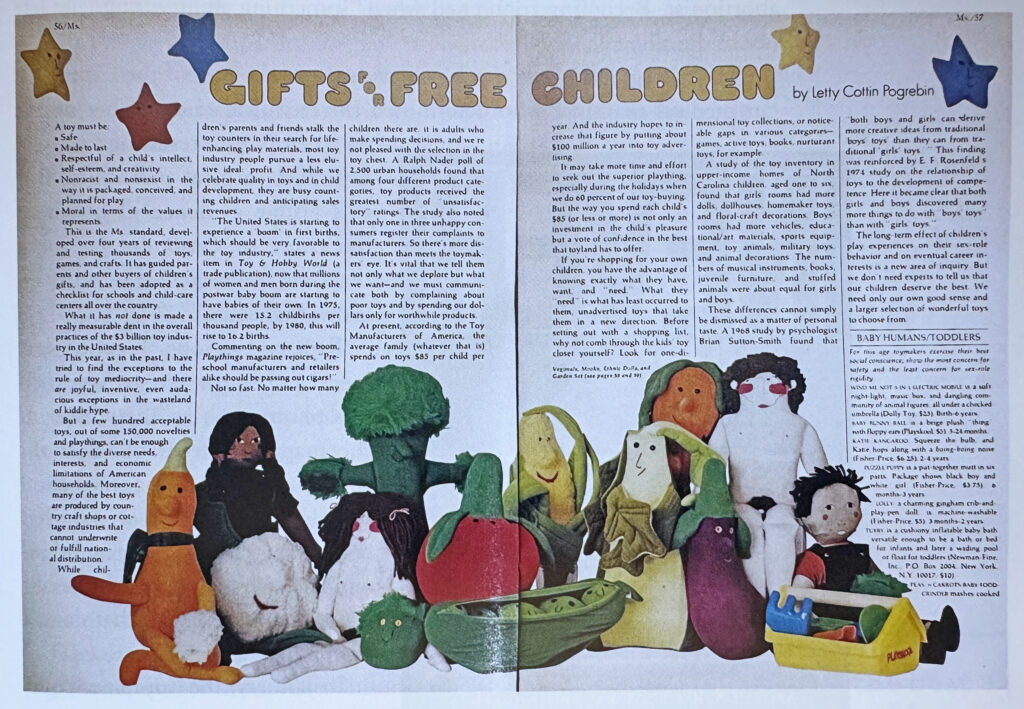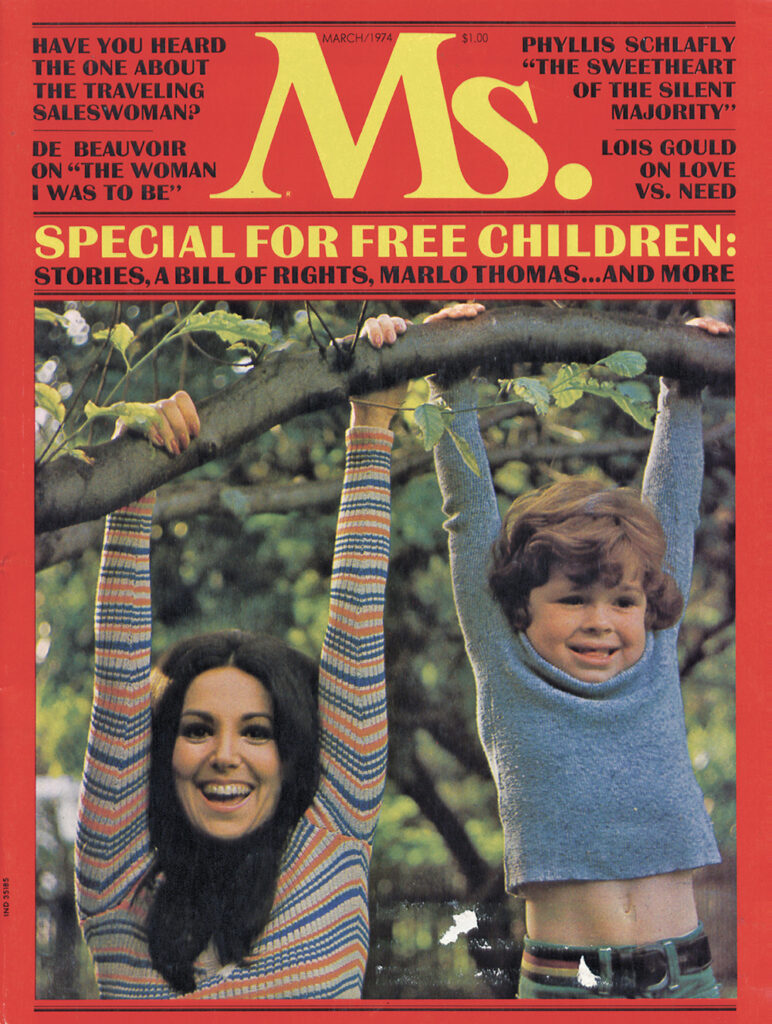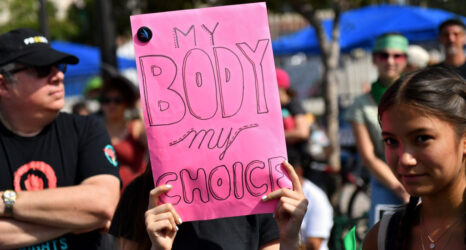The impetus for a landmark California law is straight out of 1970s toy campaigns against gender-based marketing—like Ms. magazine’s “Toys for Free Children.”

Fifty years ago, the December issue of Ms. magazine featured a no-holds-barred toy buying guide by the magazine’s firebrand co-founder and editor Letty Cottin Pogrebin, titled “Toys for Free Children.” Year-end articles on toy buying were a mainstay of women’s magazines, but none had ever suggested that what mothers bought (or boycotted) at Toys ‘R’ Us could be a feminist act. The times had changed. But the toy industry hadn’t.
As usual, Pogrebin was not going to take notice and do nothing. “Why not use consumer power,” she wrote, “to reform the Neanderthals?”
As Pogrebin reported, every kind of toy—from train sets, to board games, to kitchen toys—were marketed exclusively to either boys or girls. Belittling or sexualizing images of women were ubiquitous. And when it came to science and educational toys, only boys populated the packages and the advertising. The feminine mystique was still alive and well in Toyland.

It may be no surprise that one of the first toys sent to the gallows for its perceived anti-revolutionary politics was Barbie. As Barbara Calder of the New York chapter of the National Organization for Women (NOW) put it: “The boys are encouraged to have all the adventures. The only adventure Barbie has is changing her clothes.” Different from the Barbie discourse of this past summer, isn’t it?
Pogrebin’s blistering critique of the toy business gave voice and a national profile to a grassroots toy movement that had taken the industry by storm earlier that year. 1973 was the moment when members of NOW not only formed a subcommittee on toys, but also, at the organization’s annual meeting, founded a new industry watchdog group called the Public Action Coalition on Toys. The coalition would soon give out awards to companies that met their standards for socially progressive playthings—and become a major thorn in the side of the toy business leaders.
This was also the time NOW chapters across the country began visiting toy stores to tally the extent of stereotyping in toys. Protests and petition campaigns ensued, with leaflets carrying slogans like, “A good toy is good for a girl or a boy.” Equal play had joined equal pay on the feminist agenda.

Leaders at Ms. and NOW were also joined by the Women’s Action Alliance, which had just launched the Non-Sexist Child Development Project, under the direction of Barbara Sprung. Dissatisfied with the representational toys available for young children, Sprung initiated a longstanding partnership with the Milton Bradley Company to manufacture the first expressly non-sexist, racially diverse, and ability-inclusive early childhood toys in industry history. The toys, which first appeared in 1974, were Sprung’s designs.
How did the toy business respond? A few major toy companies seemed to be listening to their critics—although it’s hard to know which ones harbored genuine sympathy for the movement’s ideals and which simply hoped to capitalize on women’s liberation chic. Purveyors of popular TV toys like Kenner and Ideal invested a ton of money to develop all-new action-oriented fashion dolls with less typically female names, like Dusty and Derry, that tried to take the Barbie template in more expressly feminist directions.
Other companies made minor, short-lived cosmetic changes to their promotional materials. Lionel Toys is a case in point. In December 1973, the famous train manufacturer held a press conference where company officials apologized for perennially excluding girls from the marketing images. The next spring, they announced, Lionel would be adding girls to the cover of their iconic catalog. Lionel followed through on its promise in 1974, but never again after that.
As the Lionel example shows, some manufacturers treated feminism as a fad. Stereotypes sold. Why change the formula? And yet as sociologist Elizabeth Sweet found in her research into the history of gender-typed retailing at Sears, the mid-1970s were the heyday of gender-neutral or non-gendered toy promotions. Whatever the exact combination of forces, the feminist toy campaigns had helped bring about a major victory.
The feminist toy campaigns also changed the way Americans think and talk about toys.
By the end of the 1970s, nonsexist toy buying had become a cornerstone of progressive parenting.
Fast forward half a century, and members of the generation who grew up in the newly liberal toy culture of the Ms. Foundation-sponsored Free To Be…You and Me, where boys were given baby dolls and girls could play with Tonka trucks, are now revitalizing the campaigns for nonsexist toys. What’s new is that instead of marching in the streets for a more gender-diverse commercial children’s culture, they’re legislating it.

On Jan. 1, 2024, California will officially begin enforcing Assembly Bill 1084, a landmark bill in the movement for a more inclusive toy culture. Reinforcing the traditional gender binary through toys, for the first time in history, will be a civil offense. The bill opens by invoking a 1959 California civil rights law that prohibits businesses from discriminating against consumers of a protected class. In this case, it’s gender identity.
Under the law, big-box stores like Walmart can still have aisles labeled for boys or for girls, but those who choose to do so will also be required to create a gender-neutral toy section on the same floor. Those who violate the law will be subject to a fine. The impetus for the legislation—co-sponsored by current California Assemblymember Evan Low and former Assemblymember Cristina Garcia—is straight out of the 1970s toy campaigns. As the law states, the conventional gendered approach to toy selling “incorrectly implies that their use by one gender is inappropriate.”
Store locations that sell childcare items or toys [must] maintain a gender neutral section or area … in which a reasonable selection of the items and toys for children that it sells shall be displayed, regardless of whether they have been traditionally marketed for either girls or for boys.
California Assembly Bill 1084
When Gov. Gavin Newsom first signed the bill into law in 2021, Lego, the largest toy company in the world, responded that it would soon take steps toward “making Lego play more inclusive.” Not since Lionel’s mea culpa in 1973 had a major toy company publicly admitted that gender-based exclusions were a problem. Lego’s announcement—like Mattel’s introduction of its Creatable World line of gender-nonconforming dolls two years earlier—was yet another indication that toy manufacturers were feeling the pressure from those who want gender-diverse representation.
Anyone who wants to see toys better represent the people we are, and the world we live in, have two options:
- They can wait and see whether leading toymakers will follow Lego in building a more progressive toy culture; after all, with more and more people buying toys online, any lasting changes will need to be made by the manufacturers, not Walmart. Or…
- They can blow the dust off the Pogrebin playbook to launch a new toy campaign that not only restores the hard-won achievements of the 1970s—a Sears catalog that presents all toys as good for kids of all genders—but updates its goals of inclusion and diversity to reflect where we are now.
If we as parents and consumers can’t influence the toy world, what hope can we have to change the real one?
Up next:
U.S. democracy is at a dangerous inflection point—from the demise of abortion rights, to a lack of pay equity and parental leave, to skyrocketing maternal mortality, and attacks on trans health. Left unchecked, these crises will lead to wider gaps in political participation and representation. For 50 years, Ms. has been forging feminist journalism—reporting, rebelling and truth-telling from the front-lines, championing the Equal Rights Amendment, and centering the stories of those most impacted. With all that’s at stake for equality, we are redoubling our commitment for the next 50 years. In turn, we need your help, Support Ms. today with a donation—any amount that is meaningful to you. For as little as $5 each month, you’ll receive the print magazine along with our e-newsletters, action alerts, and invitations to Ms. Studios events and podcasts. We are grateful for your loyalty and ferocity.





